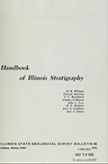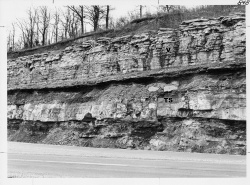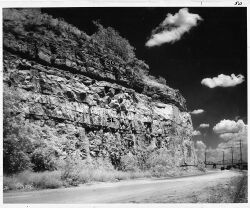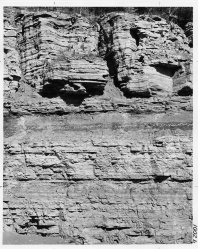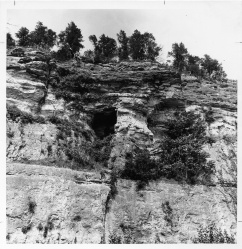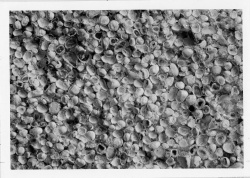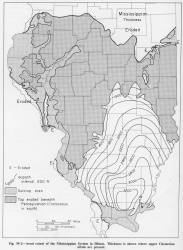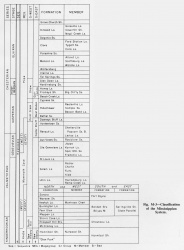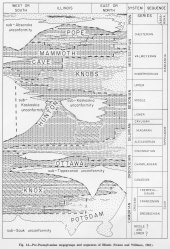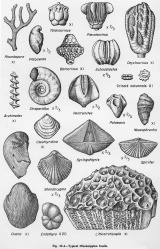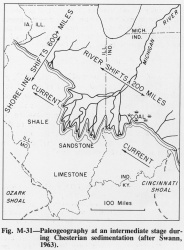Historical:Mississippian System
Chronostratigraphy: Paleozoic Erathem >>Mississippian Subsystem
Allostratigraphy: Kaskaskia Sequence
Authors
Elwood Atherton, Charles Collinson, and Jerry A. Lineback
Name Origin
The Mississippian System (Winchell, 1869; Williams, 1891), which overlies the Devonian System and underlies the Pennsylvanian System, is named from exposures in the bluffs of the Mississippi River in Iowa, Illinois, and Missouri (fig. M-1).
|
Other Names
In earlier reports these strata were called "Carboniferous limestone," or "Lower Carboniferous" (Worthen, 1866) to differentiate them from the upper Carboniferous or "Coal Measures," that are now called the Pennsylvanian System. "Carboniferous" continues to be used in other countries, and the U.S. Geological Survey recognizes the Mississippian and Pennsylvanian Systems as the Carboniferous Systems (Keroher, 1970).
Extent and Thickness
The Mississippian System is well developed in the Illinois Basin east of the type exposures, and it covers most of Illinois south of a line running roughly from Monmouth, Warren County, to Hoopeston, Vermilion County (fig. M-2). It crops out in a belt around the western and southern rim of the Illinois Basin from Henderson County on the west through Hardin County on the southeast, but on the north side of the basin it is overlapped by Pennsylvanian strata and does not crop out. In northeastern Illinois it is at the top of the bedrock but is covered by glacial drift. The system is over 3200 feet thick in southern Illinois but thins northward because of truncation and because of depositional thinning of many of its component formations (fig. M-3).
Stratigraphic Position
The Mississippian System overlies the Devonian System and underlies the Pennsylvanian System. The boundary between the Devonian and Mississippian Systems occurs in the New Albany Shale Group. Its exact position has long been controversial, but it is now widely accepted, on the basis of conodont evolution, as probably occurring near the base of the Hannibal Shale, above the Louisiana Limestone, and probably in or below the highly variable "Glen Park" Formation (Collinson et al., 1971). The Louisiana Limestone is present in only a small area, and the Devonian-Mississippian boundary commonly occurs within the shale sequence. The contact is generally conformable, but in western Illinois a minor unconformity marks the contact of the "Glen Park" Formation on the Louisiana Limestone.
The contact between the Mississippian and Pennsylvanian Systems is one of the major unconformities in Illinois and is the boundary between the Absaroka Sequence and the Kaskaskia Sequence (fig. 14). Strata in the Illinois Basin were warped, faulted, and truncated by erosion at the close of the Mississippian Period. Valleys as much as 450 feet deep were cut into Chesterian strata and subsequently were filled with Pennsylvanian sediments (Bristol and Howard, 1971). The Pennsylvanian rocks progressively overlap older Mississippian formations northward and westward from the southern part of the Illinois Basin. Around the margin of the basin the Pennsylvanian rocks overlap older systems.
Description
Although limestone is the dominant rock type in the Mississippian System, a large siltstone delta is present in central and eastern Illinois, and shale and sandstone formations are prominent in parts of the system. The lowest part of the system consists mainly of shale and siltstone and is included in the upper part of the Knobs Megagroup (fig. 14). Limestone, which makes up most of the middle part of the system, is referred to the Mammoth Cave Limestone Megagroup. The alternating limestone-shale and sandstone-shale formations of the upper part compose the Pope Megagroup. Three major varieties of limestone occur in the system- (1) very fine-grained or lithographic, dense, medium-gray, mostly cherty limestone; (2) medium- to coarse-grained, light gray, crinoidal or bryozoan limestone, part of it very cherty; and (3) medium- to coarse-grained, light gray to white, oolitic limestone. The shales are mainly dark greenish gray, but thin beds of red and green shale are extensive. The sandstones are very fine to fine grained and light gray or light greenish gray. The siltstones are light greenish gray.
Three series, all with type localities in Illinois, are differentiated at time planes established by differences in faunas. The Kinderhookian Series, at the base, is dominantly shale and is relatively thin. The Valmeyeran, in the middle, is relatively thick and is dominantly limestone and siltstone. The Chesterian, at the top, is is also thick and consists of alternations of limestone-shale and sandstone-shale formations.
Fossils
Much of the limestone and shale is exceedingly fossiliferous (fig. M-4). Brachiopods are particularly numerous, with spiriferids and productids most abundant. The Burlington Limestone, and, to a lesser extent, the Keokuk Limestone consist mainly of crinoidal debris and are zoned on the basis of crinoid genera and species. Fenestrate bryozoan debris, mostly of Archimedes, is abundant in some beds in the Warsaw, Salem, and Ullin Formations. Blastoids, particularly pentremitids, are characteristic of some limestone units in the Chesterian Series, as are Schizoblastus and Metablastus in the Valmeyeran and Orophocrinus and Globocrinus in the Kinderhookian. Shark teeth are common in some beds of the Burlington and Keokuk Limestones, and Foraminifera, particularly endothyrids, are abundant in the Salem Limestone. Conodonts are common to abundant throughout the Mississippian and provide a basis for biostratigraphic zonation (Collinson et al., 1962). Thin beds of coal occur in the Chesterian (late Mississippian) sandstones, and the megaspores in the coals indicate dominance of a lepidocarp-lepidodendrid flora (Winslow, 1959).
Depositional Environment
The main sources of the siliceous clastic sediments in the Mississippian System appear to have been northeast of Illinois, although some sediment came from the northwest and minor quantities from the Ozark region. The delta represented by the Borden Siltstone grew southeastward into the Illinois Basin. The Chesterian sands were carried into the basin by the Michigan River, which also came from the northeast (fig. M-31). The sands are moderately angular and lack the high degree of rounding characteristic of older sandstones, which were probably beneath the seas or buried by younger formations during Mississippian time.
References
BRISTOL, H. M., and R. H. HOWARD, 1971, Paleogeologic map of the sub-Pennsylvanian Chesterian (upper Mississippian) surface in the Illinois Basin: Illinois State Geological Survey Circular 458, 14 p.
COLLINSON, CHARLES, C. B. REXROAD, and T. L. THOMPSON, 1971, Conodont zonation of the North American Mississippian: Geological Society of America Memoir 127, p. 353-395; Illinois State Geological Survey Reprint 1972-A.
COLLINSON, CHARLES, A. J. SCOTT, and C. B. REXROAD, 1962, Six charts showing biostratigraphic zones and correlations based on conodonts from the Devonian and Mississippian rocks of the Upper Mississippi Valley: Illinois State Geological Survey Circular 328, 32 p.
KEROHER, G. C., 1970, Lexicon of geologic names of the United States for 1961-1967: USGS Bulletin 1350, 848 p.
WILLIAMS, H. S., 1891, Correlation papers-Devonian and Carboniferous: USGS Bulletin 80, 279 p.
WINCHELL, ALEXANDER, 1869, On the geological age and equivalents of the Marshall group: American Philosophical Society, Proceedings, v. 11, p. 57-82.
WINSLOW, M. R., 1959, Upper Mississippian and Pennsylvanian megaspores and other plant microfossils from Illinois: Illinois State Geological Survey Bulletin 86, 135 p.
WORTHEN, A. H., 1866, Geology: Geological Survey of Illinois, v. 1, 504 p.
ISGS Codes
| Stratigraphic Code | Geo Unit Designation |
|---|---|
